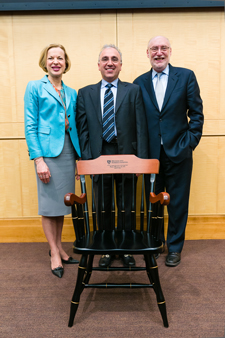Khorasani Named First
Incumbent of Chair in Imaging Informatics

|
BWH President Betsy Nabel, MD, Radiology
Vice Chair Ramin Khorasani, MD, and Radiology
Chair Steven Seltzer, MD. |
On March 11, members of Radiology's Division of Medical
Imaging Information Technology (MIIT) and Center for Evidence Based Imaging
(CEBI) gathered in the Bornstein Amphitheater to celebrate the establishment of
the Medical Imaging Information Technology Chair at Brigham and Women's
Hospital and to honor MIIT and CEBI Director Ramin Khorasani, MD, MPH as the
chair's first incumbent.
"BWH was an early adopter of and national leader in the
development and use of electronic health records," said BWH President Elizabeth
Nabel, MD. "I am delighted to see the establishment of a new chair that
underscores our commitment to the innovative use of information technology, and
that Dr. Khorasani is being recognized as the chair's first incumbent for his
pioneering contributions in this field."
Since becoming the director of Radiology's Information
Management Division in 1997, Khorasani has led the design, creation and
implementation of multiple web-enabled software tools and applications. His
first major project was to create the computerized physician order entry
system, called Percipio. This system, which transmits more than 700,000 imaging
orders per year, enables online appointment scheduling and desktop viewing of
images and reports. It also contains Decision Support tools that help doctors
select the best type of test for a particular patient. The use of this
application has contributed to faster report turnaround times, improved
workflow efficiency for radiologists and referring physicians, and the
reduction of inappropriate ordering tests.
The implementation of Percipio also enabled Khorsani's teams
to use it as the platform for added functions that streamline clinical
interactions between radiologists and referring physicians. Now, when a
radiologist makes an unexpected or critical finding on an image, she or he
launches the Alert Notification of Critical Results (ANCR) application and
triggers an automated message about the finding that is emailed and paged to
the referring physician. Collaborations among members of the Emergency
Radiology section, database design experts, and device manufacturers are making
possible the collection of radiation dose information from each CT scan that is
performed at the hospital. Posted to the patient's electronic health record,
this information plays a central role in physicians' decisions over the best
type of imaging for tests for patients with a wide range of conditions.
With even more powerful imaging devices on the horizon, the
ability of IT systems to collect, transmit, and assemble billions of bits of
data in a way that is seamless and user-friendly to physicians and nurses will
be the next generation of health care IT designers' call to action. As Khorasani
stated in his acceptance speech:
"From functional and molecular imaging applications,
ultra-high field strength MR magnets, to the fusion of images that combine
studies performed on advanced imaging modalities like CT and MRI, we are seeing
the emergence of imaging technology and applications that will test IT systems'
abilities to transmit, organize and store billions of bits of data daily. The
establishment of this chair by the Department of Radiology and BWH leadership signals
our hospital's commitment to ensuring we have the IT infrastructure that will
continue to focus on enhancing the clinical value of the exchange of so much
information."